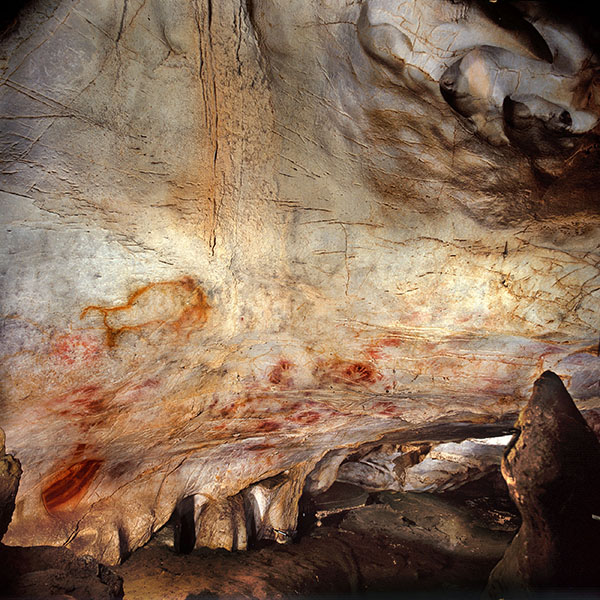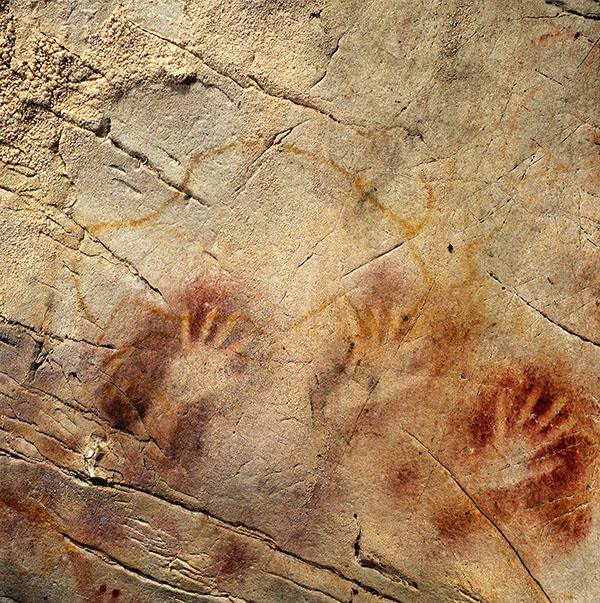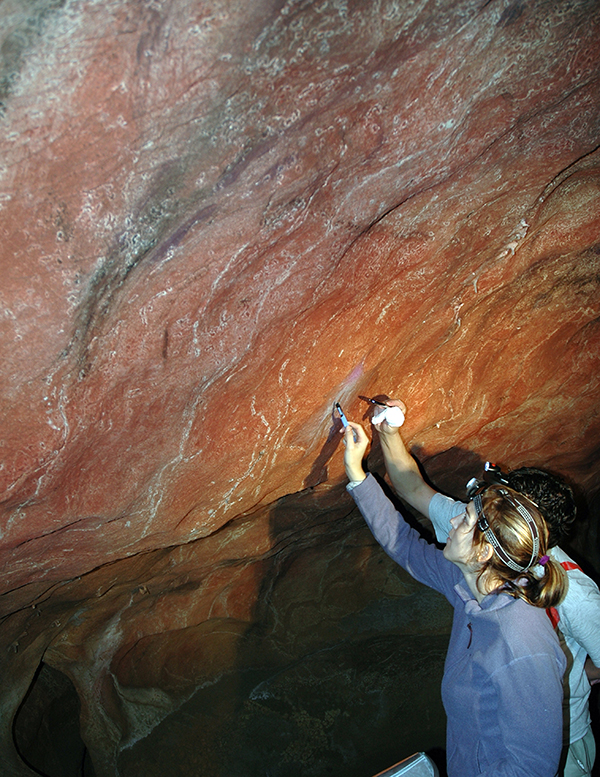
by Jay R. Thompson Thursday, June 14, 2012

Scientists have redated art in El Castillo Cave in Spain. The new dates place a hand stencil at earlier than 37,300 years ago and a red disk at earlier than 40,600 years ago — the oldest cave paintings in Europe. Image courtesy of Pedro Saura

The Panel of Hands in El Castillo Cave. Scientists have found a new date for a hand stencil: It is at least 37,300 years old. Image courtesy of Pedro Saura

Researchers removing calcite samples for dating from Tito Bustillo Cave, Spain. New dates put the art at between 29,000 and 36,000 years old. Image courtesy of Rodrigo De Balbín Behrmann
Scientists have studied Paleolithic cave art for more than a century, but new research suggests paintings and carvings in some Spanish caves are thousands of years older than previously thought, which would make them the oldest cave art in Europe. The new evidence has left researchers wondering if the artists were modern humans or Neanderthals.
Modern humans are thought to have spread throughout Europe starting between 42,000 and 41,000 years ago. The earliest European cave paintings to date, in Grotte Chauvet, France, have been dated to 37,000 to 35,000 years old and attributed to modern humans.
In a new study published Friday in Science, Alistair Pike, a reader in archaeological science at the University of Bristol in England and his colleagues reported that one cave painting in northwestern Spain is more than 40,000 years old. Pike and his team sampled 50 paintings and engravings in 11 Spanish caves, including the UNESCO World Heritage sites of Altamira, El Castillo and Tito Bustillo. “When we put this project together, the idea was to improve the chronology of cave art,” said João Zilhão, a research professor in archaeology at the University of Barcelona in Spain and a co-author of the study, at a press conference to announce the findings.
The team used uranium-thorium dating, a technique that has become more attractive in recent years because the required sample size has shrunk, said Pike at the press conference. “Perhaps 20 years ago, we would have needed a whole gram of material,” Pike said. “Now we need 1/100 of that size — about 10 milligrams.” That’s about the size of a grain of rice.
Researchers sampled the calcite deposits to date the art. If thin calcite stalactites had accumulated over a painting, the artwork must be older than the calcite deposit, so the researchers scraped at the calcite until they were just above the surface of the artwork and then sampled the calcite closest to the painting.
The team found varying minimum ages for the painted designs, including a claviform-like symbol, a hand stencil and a red disk, of 35,600 years old, 37,300 years old and 40,800 years old, respectively — bringing cave art toe-to-toe with the arrival of humans in Europe.
The same cave paintings were previously dated at younger than 25,000 through radiocarbon dating, Pike told EARTH. “But radiocarbon dating of cave art is controversial because it is prone to contamination, and also cannot date mineral pigments — such as those we dated in Spain — or engravings,” he says.
The results were a surprise to the researchers, Zilhão said. “We were not expecting this.”
Pike said the results suggest three scenarios. First, maybe modern humans were already painting caves when they reached Europe. Scientists have found no cave paintings older than humans’ arrival in Europe, but it’s possible, he said. A second possibility is that cave painting developed right after modern humans arrived in Europe, where they had to compete for resources with Neanderthals — neighbors they didn’t have in Africa. Amidst the competition, he said, maybe the rate of innovation and “cultural formation” increased among modern humans, with cave art as a byproduct. The third scenario is that someone was painting caves in Europe before modern humans got there. “Therefore, we have to introduce the possibility that [the paintings] were made by Neanderthals.”
Scientists have long known that Neanderthals were capable of producing art, as they decorated bone and ivory tools with abstract markings, used personal ornamentation and painted their bodies with “sophisticated cosmetic recipes,” Zilhão said. One of the main reasons all cave art to date has been attributed to modern humans is simply the dates. Currently, Zilhão said, there isn’t enough evidence to determine who painted the caves, but he suspects further research will point to Neanderthals as the artists. “What we have to do now is go back and find out whether we can indeed get dates older than 42,000, 43,000 [years ago].”
If scientists can date paintings at 43,000 years old, there will be little question they were done by Neanderthals, Pike told EARTH. In addition, he said, “if [the cave art] was made by Neanderthals, there is no reason it won’t turn out to be 50,000 or 60,000 years old.”
The researchers sampled only a “tiny percentage” of the cave art out there, Pike noted. Further research should be able to determine whether the paintings’ creators were Neanderthals or modern humans, he said. “I think it’s a fairly straightforward thing to prove.”
© 2008-2021. All rights reserved. Any copying, redistribution or retransmission of any of the contents of this service without the expressed written permission of the American Geosciences Institute is expressly prohibited. Click here for all copyright requests.